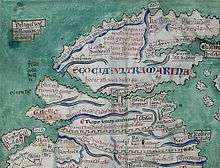Gododdin

The Gododdin (Welsh pronunciation: [ɡoˈdoðin]) were a P-Celtic speaking Brittonic people of north-eastern Britannia, the area known as the Hen Ogledd or Old North (modern south-east Scotland and north-east England), in the sub-Roman period. Descendants of the Votadini, they are best known as the subject of the 6th-century Welsh poem Y Gododdin, which memorialises the Battle of Catraeth and is attributed to Aneirin.
The name Gododdin is the Modern Welsh form, but the name appeared in Old Welsh as Guotodin and derived from the tribal name Votadini recorded in Classical sources, such as in Greek texts from the Roman period.[1]
Kingdom
It is not known exactly how far the kingdom of the Gododdin extended, possibly from the Stirling area to the kingdom of Bryneich (Bernicia), and including what are now the Lothian and Borders regions of eastern Scotland. It was bounded to the west by the Brythonic Kingdom of Strathclyde, and to the north by the Picts. Those living around Clackmannanshire were known as the Manaw Gododdin.[2][3] According to tradition, local kings of this period lived at both Traprain Law and Din Eidyn (Edinburgh, whose English name is ultimately a calque, with the Old English -burh corresponding to the Cumbric din; in Scottish Gaelic it is still known as Dùn Éideann), and probably also at Din Baer (Dunbar, Scottish Gaelic Dùn Bàrr).
Cunedda, legendary founder of the Kingdom of Gwynedd in north Wales, is supposed to have been a Manaw Gododdin warlord who migrated southwest during the 5th century.[4]
Later history
In the 6th century, Bryneich was invaded by the Angles and became known as Bernicia. The Angles continued to press north. In around 600 the Gododdin raised a force of about 300 men to assault the Angle stronghold of Catraeth, perhaps Catterick, North Yorkshire. The battle, which ended disastrously for the Britons, was memorialised in the poem Y Gododdin.
In 638 the monks of Iona record the siege of Din Eidyn (modern Edinburgh), by Domnall Brecc, King of Dál Riata but do not say whether the siege was successful or not. History provides no answers but by the middle of the 770's the Gododdin seem to have come under the rule of Northumbria and perhaps the Picts. After the Picts inflicted a crushing defeat on the Northumbrians at the Battle of Dun Nechtain in 685 the Gododdin sacked the Northumbrian monastery at Abercorn to the west of Edinburgh and according to Bede regained their freedom but the kingdom never re-emerged and the Gododdin disappear into history.
See also
Notes
- ↑ Claudius Ptolemaeus, "Geographia" (ca. 2nd century)
- ↑ Watson, 1926
- ↑ Jackson, 1969
- ↑ Historia Britonum, retrieved 4 April 2009.
References
- Kenneth H. Jackson (1969). The Gododdin: The Oldest Scottish poem (Edinburgh: University Press) * W.J. Watson (1926, 1986). The History of the Celtic Place-Names of Scotland: being the Rhind lectures on archaeology (expanded) delivered in 1916. (Edinburgh, London: W. Blackwood & Sons, 1926; Edinburgh: Birlinn, 1986, reprint edition). ISBN 1-874744-06-8
- W.J. Watson (1926, 1986). The History of the Celtic Place-Names of Scotland: being the Rhind lectures on archaeology (expanded) delivered in 1916. (Edinburgh, London: W. Blackwood & Sons, 1926; Edinburgh: Birlinn, 1986, reprint edition). ISBN 1-874744-06-8
- Davies, John. "Dinas Powys, Catraeth, and Llantwit Major." A History of Wales. London: Allen Lane :, 1993. 61-62. Print.
- Davies, Norman. "The Germanico-Celtic Isles." The Isles: A History. Oxford: Oxford UP, 1999. 165-166, 185-187, 195, 207. Print.
Further reading
- Ian Armit (1998). Scotland's Hidden History (Tempus [in association with Historic Scotland]) ISBN 0-7486-6067-4
- Stuart Piggott (1982). Scotland Before History (Edinburgh: University Press) ISBN 0-85224-348-0
- Woolf, Alex, ed. (2013). Beyond the Gododdin: Dark Age Scotland in Medieval Wales. Proceedings of a Day Conference Held on 19 February 2005. St Andrews, UK: The Committee for Dark Age Studies, University of St Andrews. ISBN 978-0-9512573-8-8.
External links
- Skene, William Forbes (1869), The Gododdin Poems, Forgotten Books (published 2007), p. 108, ISBN 1-60506-167-0, retrieved 2008-08-09
